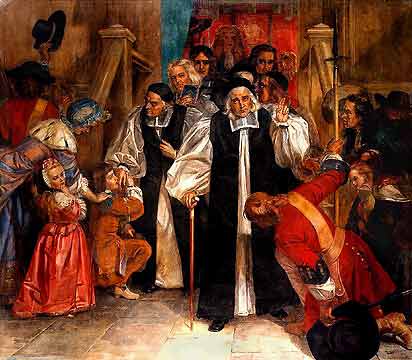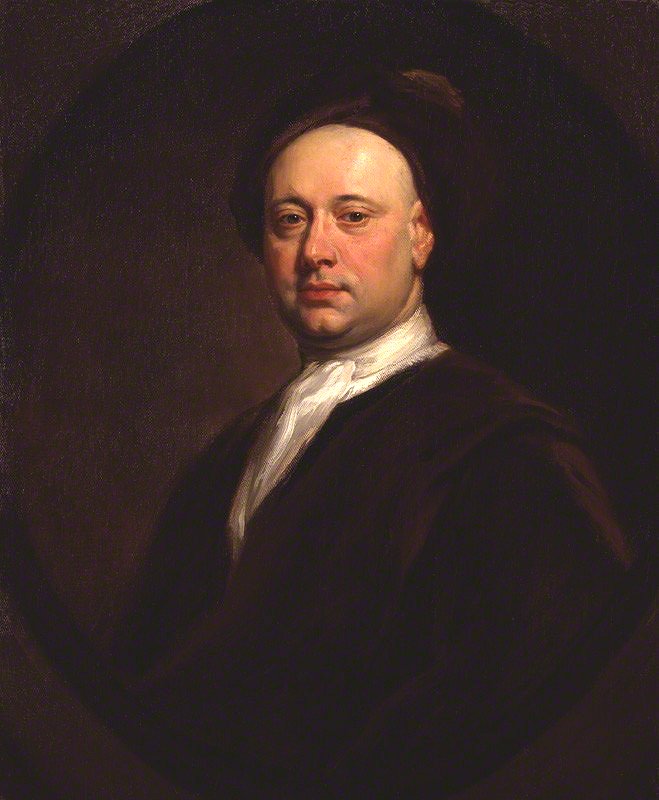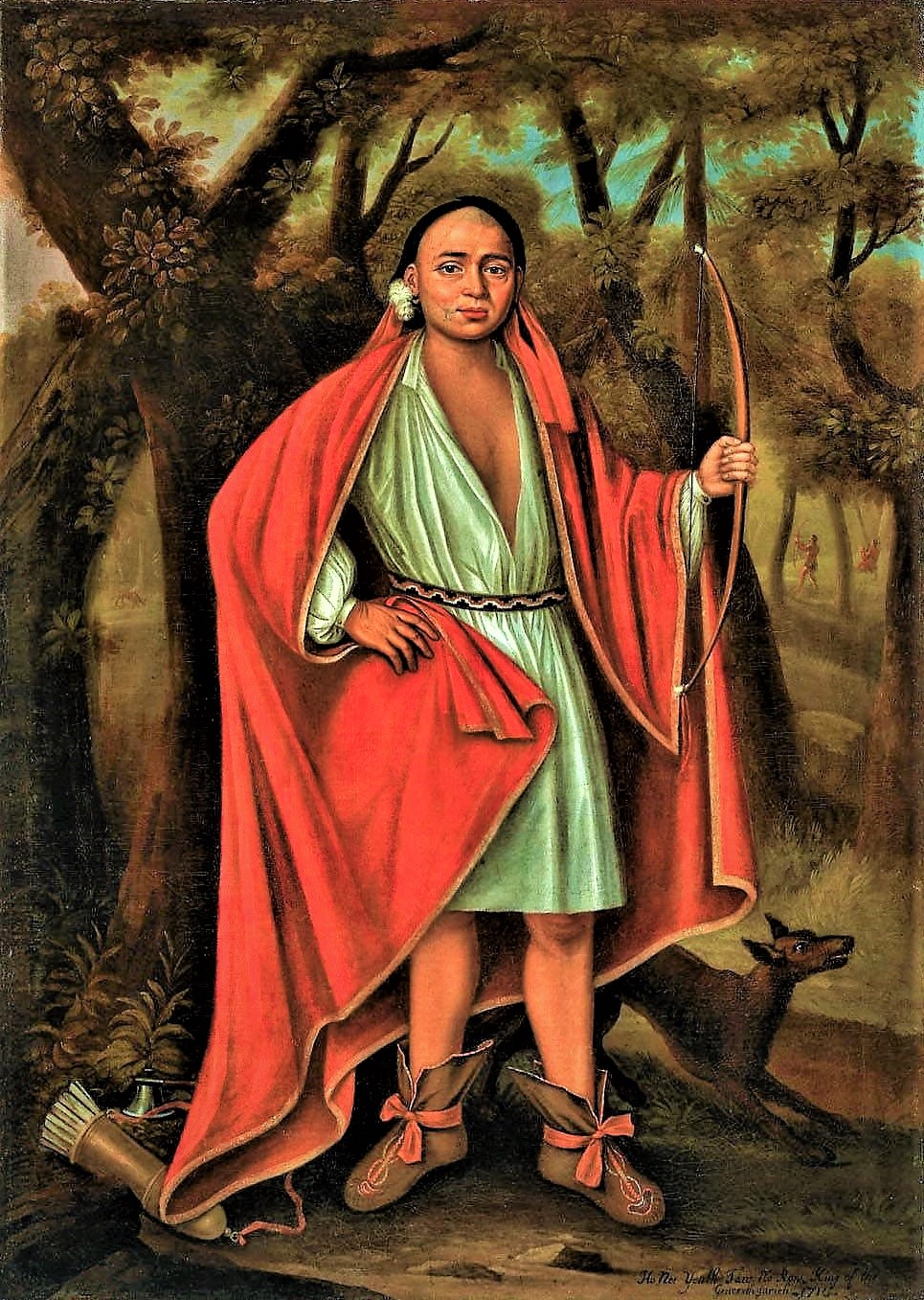|
Ralph Taylor D.D
Ralph Taylor (1647 – 26 December 1722) was an English clergyman, nonjuror and sometime chaplain to the court of James II at Saint-Germain-en-Laye. Life Son of Revd William Taylor and Judith Charlett of South Littleton. Educated Trinity College, Oxford, matriculated 22 March 1666 – 1667; BA 1670; MA 1673; BD 1682; DD 1686. Installed as rector of Grafton Flyford 1678, then in 1684 as rector of Severn Stoke. Some of the entries in the parish book of Severn Stoke written in Taylor's hand suggest that he had no great respect or honour for James II: Having previously sworn an oath of allegiance to James II of England, he refused to take the oath of allegiance to William and was deprived of the living. Taylor remained in Worcestershire with some contact with George Hicks, nonjuring Dean of Worcester. By 1699, Taylor was chaplain to the court of James II at Saint-Germain-en-Laye. Little is known of his time there beyond that he attended the funeral of Denis Granvill ... [...More Info...] [...Related Items...] OR: [Wikipedia] [Google] [Baidu] |
Nonjuring Schism
The Nonjuring schism refers to a split in the State religion, established churches of England, Scotland and Ireland, following the deposition and exile of James II of England, James II and VII in the 1688 Glorious Revolution. As a condition of office, clergy were required to swear allegiance to the ruling monarch; for various reasons, some refused to take the oath to his successors William III of England, William III and II and Mary II of England, Mary II. These individuals were referred to as ''Non-juring'', from the Latin verb ''iūrō'', or ''jūrō'', meaning "to swear an oath". In the Church of England, an estimated 2% of priests refused to swear allegiance in 1689, including nine bishops. Ordinary clergy were allowed to keep their positions but after efforts to compromise failed, the six surviving bishops were removed in 1691. The schismatic Non-Juror Church was formed in 1693 when William Lloyd (bishop of Norwich), Bishop Lloyd appointed his own bishops. His action was opp ... [...More Info...] [...Related Items...] OR: [Wikipedia] [Google] [Baidu] |
Anne, Queen Of Great Britain
Anne (6 February 1665 – 1 August 1714) was Queen of England, Scotland and Ireland from 8 March 1702 until 1 May 1707. On 1 May 1707, under the Acts of Union, the kingdoms of England and Scotland united as a single sovereign state known as Great Britain. Anne continued to reign as Queen of Great Britain and Ireland until her death. Anne was born in the reign of Charles II to his younger brother and heir presumptive, James, whose suspected Roman Catholicism was unpopular in England. On Charles's instructions, Anne and her elder sister Mary were raised as Anglicans. Mary married their Dutch Protestant cousin, William III of Orange, in 1677, and Anne married Prince George of Denmark in 1683. On Charles's death in 1685, James succeeded to the throne, but just three years later he was deposed in the Glorious Revolution of 1688. Mary and William became joint monarchs. Although the sisters had been close, disagreements over Anne's finances, status, and choice of acquaintances ar ... [...More Info...] [...Related Items...] OR: [Wikipedia] [Google] [Baidu] |
1649 Births
Events January–March * January 4 – In England, the Rump Parliament passes an ordinance to set up a High Court of Justice, to try Charles I for high treason. * January 17 – The Second Ormonde Peace concludes an alliance between the Irish Royalists and the Irish Confederates during the War of the Three Kingdoms. Later in the year the alliance is decisively defeated during the Cromwellian conquest of Ireland. * January 20 – Charles I of England goes on trial, for treason and other "high crimes". * January 27 – King Charles I of England, Scotland and Ireland is found guilty of high treason in a public session. He is beheaded three days later, outside the Banquet Hall in the Palace of Whitehall, London. * January 29 – Serfdom in Russia begins legally as the Sobornoye Ulozheniye (, "Code of Law") is signed by members of the Zemsky Sobor, the parliament of the estates of the realm in the Tsardom of Russia. Slaves and free peasants are con ... [...More Info...] [...Related Items...] OR: [Wikipedia] [Google] [Baidu] |
British Museum
The British Museum is a public museum dedicated to human history, art and culture located in the Bloomsbury area of London. Its permanent collection of eight million works is among the largest and most comprehensive in existence. It documents the story of human culture from its beginnings to the present.Among the national museums in London, sculpture and decorative and applied art are in the Victoria and Albert Museum; the British Museum houses earlier art, non-Western art, prints and drawings. The National Gallery holds the national collection of Western European art to about 1900, while art of the 20th century on is at Tate Modern. Tate Britain holds British Art from 1500 onwards. Books, manuscripts and many works on paper are in the British Library. There are significant overlaps between the coverage of the various collections. The British Museum was the first public national museum to cover all fields of knowledge. The museum was established in 1753, largely b ... [...More Info...] [...Related Items...] OR: [Wikipedia] [Google] [Baidu] |
George Vertue
George Vertue (1684 – 24 July 1756) was an English engraver and antiquary, whose notebooks on British art of the first half of the 18th century are a valuable source for the period. Life Vertue was born in 1684 in St Martin-in-the-Fields, London, his father, perhaps a tailor, and mother are noted as 'Roman Catholic'. At the age of 13, he was apprenticed to a prominent heraldic engraver of French origin who became bankrupt and returned to France. Vertue worked seven years under Michael Vandergucht, before operating independently. He was amongst the first members of Godfrey Kneller's London Academy of Painting, who had employed him to engrave portraits. citing: Walpole's ''Anecdotes of Painting''; Nichols's ''Literary Anecdotes'', ii. 246; Chester's ''Westminster Abbey Reg.''; Dodd's manuscript ''Hist. of English Engravers'' in Brit. Mus. (Addit. MS. 33406). It was there that he became a pupil of Thomas Gibson, a leading portrait painter. Vertue had a deep interest in antiqu ... [...More Info...] [...Related Items...] OR: [Wikipedia] [Google] [Baidu] |
John Verelst
John Verelst, born and known also as Johannes or Jan (29 October 1648 – 7 March 1734), was a Dutch Golden Age painter. He was the youngest of three sons of the painter Pieter Hermansz Verelst; all became known as painters. He is known for his portraits, especially of the men known as the Four Mohawk Kings, who visited Queen Anne in 1710 from the Province of New York in North America. (One of these men has since been identified correctly instead as a chief of the Mohican, a different tribe.) Biography Johannes Verelst was born in The Hague as the youngest son of Pieter Hermansz Verelst, a painter, and his wife. His older brothers were Simon and Herman. All three of these sons became painters, studying with their father from when they were young. After becoming established, Johannes Verelst migrated to London in 1691, where he specialized in oil portraits and became known as John Verelst. Due to Simon using a slanting "S" in his signatures, flower still lifes in the manner of S ... [...More Info...] [...Related Items...] OR: [Wikipedia] [Google] [Baidu] |
Richard Welton
Richard Welton (1671/1672 – 22 July 1726) was an English Anglican non-juror. Welton was born in Framlingham, Suffolk. His father was Thomas Welton, a druggist from Woodbridge, Suffolk. Welton was educated at Gonville and Caius College, Cambridge, where he successively graduated BA in 1692, MA in 1695 and DD in 1708. He married Temperance Goodwyn and they had a son, Richard, who was baptised in 1708.Robert D. Cornwall, �Welton, Richard (1671/2–1726)��, ''Oxford Dictionary of National Biography'', Oxford University Press, 2004, accessed 2 Aug 2014. Being ordained in 1695, Welton was rector of St Mary's, Whitechapel, from 1697 to 1715. In 1714 Welton conceived of a plan to place in the church an altarpiece depicting the Last Supper, with a Whig clergyman as Judas. The painter, James Fellowes, was instructed to portray Bishop Burnet in the semblance of Judas, but, fearing the consequences, he obtained permission to substitute Dean White Kennett with the words "The Dean the ... [...More Info...] [...Related Items...] OR: [Wikipedia] [Google] [Baidu] |
Heneage Finch, 5th Earl Of Winchilsea
Heneage Finch, 5th Earl of Winchilsea FSA (1657 – 30 September 1726) was an English peer, styled Hon. Heneage Finch until 1712. He was the son of Heneage Finch, 3rd Earl of Winchilsea and Mary Seymour. He was born on 3 January 1657 and baptised on 11 January in the same year. The Finch family were traditional royalists. At the Restoration, King Charles II recommended Winchelsea to be ambassador to the Porte. He arrived at Constantinople on 17 January 1661. He was eventually recalled by letter on 19 December 1667. He did not leave Turkey until early 1669. In 1683, he was appointed a Groom of the Bedchamber to the Duke of York and a captain in the Duke's Halberdiers, and was created a D.C.L of Oxford. In 1685, he retained his appointment as Groom of the Bedchamber when York succeeded as James II, was commissioned a colonel, and appointed a deputy lieutenant for Kent. He represented Hythe in James' only Parliament. He lost his posts upon the deposition of James but remaine ... [...More Info...] [...Related Items...] OR: [Wikipedia] [Google] [Baidu] |
Henry Gandy
Henry Gandy (1649–1734) was an English non-juring bishop. Life The son of John Gandy of South Brent, Devon, he was born on 14 October 1649; his father was a priest of the Church of England who had been deprived of his living during the English Civil War. He entered Merchant Taylors' School in 1663, and went on to Oriel College, Oxford, where he matriculated on 15 March 1667. He graduated B.A. 17 October 1670, M.A. in 1674, and was elected Fellow on 30 November 1670. He served as a proctor, elected 18 April 1683. Gandy was senior fellow of Oriel when he was deprived for refusing the oath of allegiance to William III and Mary II, in 1690. As a nonjuror he was a leading if anonymous controversialist; and advocated for maintaining the schism in the Church of England, when Thomas Ken, the sole survivor of the original deprived bishops, in 1710 expressed a wish that the breach should be closed. At that point Henry Dodwell, Robert Nelson and Francis Brokesby returned to the Anglica ... [...More Info...] [...Related Items...] OR: [Wikipedia] [Google] [Baidu] |
Nathaniel Spinckes
Nathaniel Spinckes (1653–1727) was an English nonjuring clergyman, a leader in the dispute among the nonjurors about the "usages" which split the "non-usagers", (those who advocated the retention of the ''Book of Common Prayer'' as it was), against returning to the first prayer-book of Edward VI, as the "usagers", led by Jeremy Collier, advocated. Life He was born at Castor, Northamptonshire, where his father, Edmund Spinckes, was rector of the parish. His mother was Martha, eldest daughter of Thomas Elmes of Lilford, to whom Edmund Spinckes was chaplain. Nathaniel received his early education from a neighbouring clergyman, Samuel Morton, rector of Haddon (then in Huntingdonshire). On 9 July 1670 he matriculated at Trinity College, Cambridge; in 1673 he migrated to Jesus College where he was elected scholar on the Rustat foundation. He graduated B.A. in 1674, and M.A. in 1677. On 21 May 1676 he was ordained deacon by Henry Compton, Bishop of London, in the chapel of Lond ... [...More Info...] [...Related Items...] OR: [Wikipedia] [Google] [Baidu] |
Gray's Inn
The Honourable Society of Gray's Inn, commonly known as Gray's Inn, is one of the four Inns of Court (professional associations for barristers and judges) in London. To be called to the bar in order to practise as a barrister in England and Wales, an individual must belong to one of these inns. Located at the intersection of High Holborn and Gray's Inn Road in Central London, the Inn is a professional body and provides office and some residential accommodation for barristers. It is ruled by a governing council called "Pension," made up of the Masters of the Bench (or "benchers,") and led by the Treasurer, who is elected to serve a one-year term. The Inn is known for its gardens (the “Walks,”) which have existed since at least 1597. Gray's Inn does not claim a specific foundation date; none of the Inns of Court claims to be any older than the others. Law clerks and their apprentices have been established on the present site since at latest 1370, with records dating from 1381 ... [...More Info...] [...Related Items...] OR: [Wikipedia] [Google] [Baidu] |
Denis Granville
Denis Granville (name altered from Grenville) (13 February 1637 – 18 April 1703) was an English non-juring cleric, Dean of Durham and then Jacobite exile. Life The youngest son of Sir Bevil Grenville, he was born 13 February 1637 and baptised at Kilkhampton, Cornwall. He matriculated as a gentleman-commoner of Exeter College, Oxford on 6 August 1658. He graduated MA in convocation 28 September 1660 and DD on 28 February 1671. About 1660 he married Anne, fourth and youngest daughter of Bishop John Cosin. Richard Sanderson ordained him in 1661 and, on 10 July in the same year, he succeeded, on the presentation of his eldest brother, John Granville, 1st Earl of Bath, to the family living of Kilkhampton. Lord Bath also obtained for him a promise of the next vacant fellowship at Eton College. Gilbert Sheldon, Archbishop of Canterbury, resisted this arrangement, but the king sent a peremptory mandate directing that it should be fulfilled. Before the next vacancy (in 1669) Gran ... [...More Info...] [...Related Items...] OR: [Wikipedia] [Google] [Baidu] |





